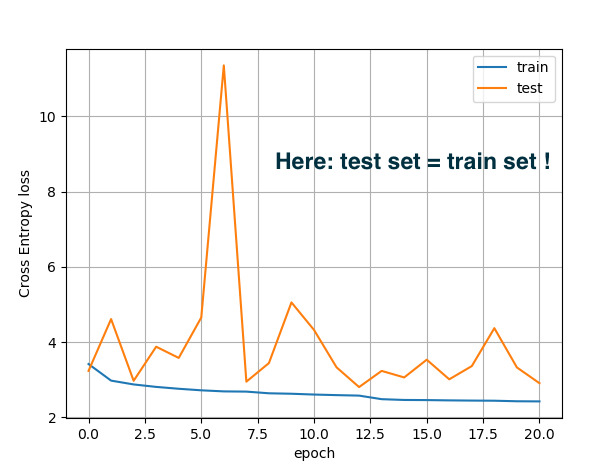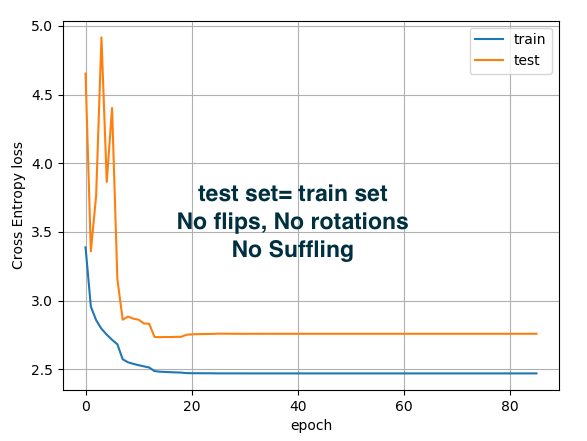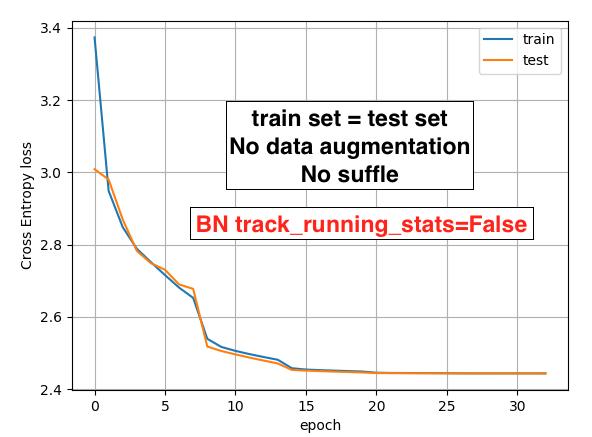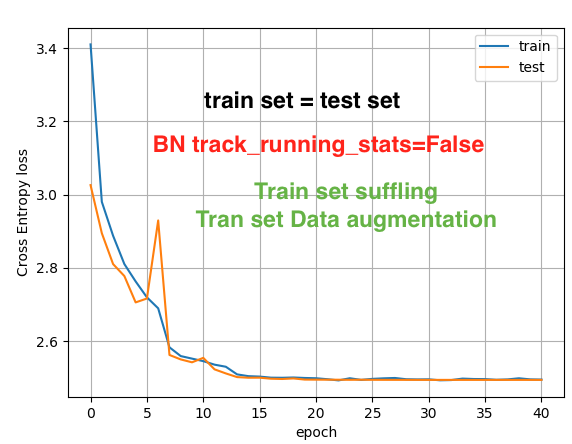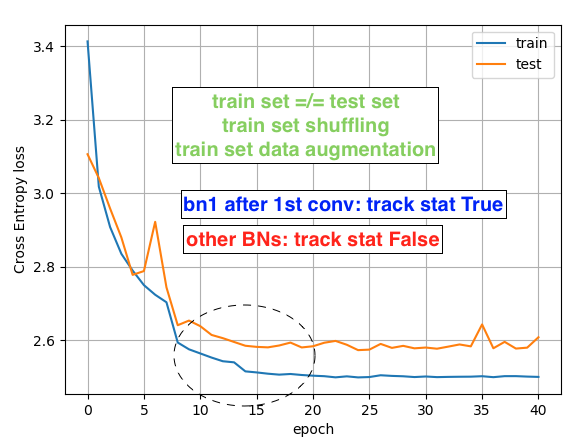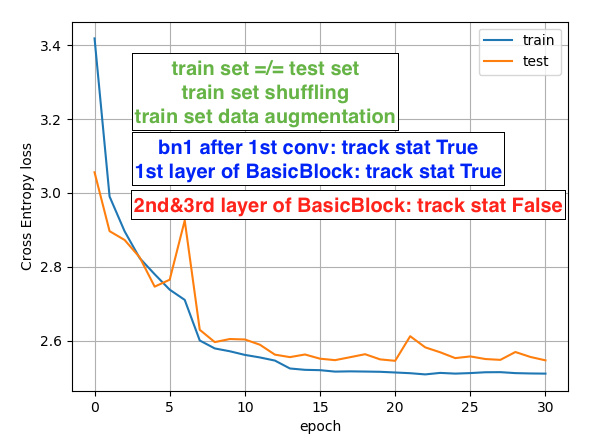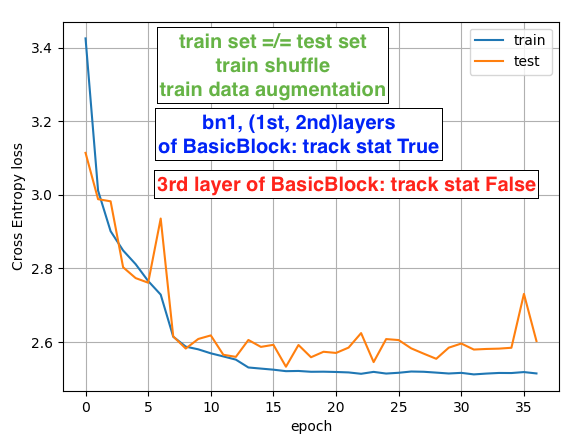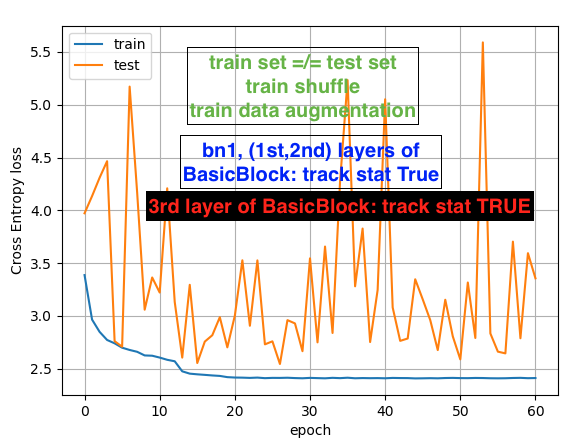Hi, Best wishes for 2020!
I have set-up a series of script to investigate the (pathologiocal) behaviour of the test loss when training a Resnet model.
As I cannot attach some files it will be a bit tedious, sorry.
(pz_synth_data.py) script to generate synthesized (rubish) data
#This is a script to produce synthetized input data
import numpy as np
from scipy.integrate import quad
from tqdm import tqdm
#####################
class ImgSynthe(object):
""" Synthetisation d'images : C x H x W """
Nfilters = 5
lambda_min0 = 0.05
lambda_max0 = 1.0
noise = 0.01
sig0 = 0.2
strength0 = 1.0
zmean = 0.12
zsig = 0.035
zmin = 0.0
zmax = 0.3
N = 64
x = (np.linspace(0,N-1,N)+0.5)/N
y = (np.linspace(0,N-1,N)+0.5)/N
xv, yv = np.meshgrid(x,y)
def __init__(self):
print("Perform synthetisation")
def shape(self,x,y,norm=1.0,muX=0.,sigX=1.0,muY=0.0,sigY=1.0,rho=0.0):
""" gaussian PSF """
rho2 = 1.0-rho*rho
sigX2 = sigX*sigX
sigY2 = sigY*sigY
return norm *\
np.exp(-0.5/rho2*((x-muX)**2/sigX2+(y-muY)**2/sigY2)-2*rho*(x-muX)*(y-muY)/(sigX*sigY))
def spec(self,x,norm=1.0,xmin=0.,xmax=1.):
""" Simple emission spectrum """
if x < xmin or x > xmax:
return 0.0
else:
return 4.0*norm*(x-xmin)*(xmax-x)/(xmax-xmin)**2
def intspec(self,a,b,norm,xmin,xmax):
""" Integrale du spectre dans [a,b] """
return quad(self.spec,a,b,args=(norm,xmin,xmax))[0]
def __call__(self):
# get z value
z = self.zsig*np.random.randn()+self.zmean
z = np.clip(z,self.zmin,self.zmax)
# update spectral shape
lambda_min = (1+z)*self.lambda_min0
lambda_max = (1+z)*self.lambda_max0
strength = self.strength0/(1+z)**2
#update shape
sig = self.sig0/(1.+z)
sigX = sig*np.random.uniform(0.1,1.0)
sigY = sig*np.random.uniform(0.1,1.0)
rho = np.random.uniform(0.,0.99)
# signal in all filters
filter_imgs = []
for p in range(self.Nfilters):
norm = self.intspec(p/5.,(p+1)/5.,strength,lambda_min,lambda_max)
#print('norm: ',norm)
img = self.shape(self.xv,self.yv,norm=norm,muX=0.5,sigX=sigX,muY=0.5,sigY=sigY,rho=rho)
img += np.random.normal(0,self.noise,size=img.shape)
filter_imgs.append(img)
# transform to float32 to gain space
imgs = np.array(filter_imgs).astype("float32") # Nfilters x H x W
# transpose for compatibility
imgs = np.transpose(imgs,(1,2,0)) # H x W x Nfilters
return { 'image': imgs, 'z':np.float32(z), 'ebv':np.float32(0.) } # ebv for compatibility
########################
def makeSet(gen,N,file="tmp.npz"):
imgs = []
zs = []
ebvs = []
for i in tqdm(range(N),ascii=True,desc=file):
data = gen()
imgs.append(data['image'])
zs.append(data['z'])
ebvs.append(data['ebv'])
zarr = np.array(zs)
zarr = np.expand_dims(zarr,axis=-1)
ebvarr = np.array(ebvs)
ebvarr = np.expand_dims(ebvarr,axis=-1)
np.savez(file,data=np.array(imgs),z=zarr,ebv=ebvarr)
################################
if __name__ == '__main__':
gen = ImgSynthe()
Ntrain = 128*10**3
makeSet(gen,Ntrain,file="train_synth_128k.npz")
Ntest = 128*10**3
makeSet(gen,Ntest,file="test_synth_128k.npz")
Ntest_ref = 10*10**3
makeSet(gen,Ntest_ref,file="test_synth_10k.npz")
print("All done. Bye")
pz_utils.py : Now a utility script to be used for the training, it deals with classes for the Data laoding and the Network design (Resnet and a simple ConvNet)
import random
import torch
import torch.nn as nn
from torchvision import transforms
from torch.utils.data import DataLoader, Dataset
import torch.optim as optim
import torch.nn.functional as F
import torch.nn.init as init #for ResNetV2
import numpy as np
########### A simple convnet ########
class PzConv2d(nn.Module):
""" Convolution 2D Layer followed by PReLU activation
"""
def __init__(self, n_in_channels, n_out_channels, **kwargs):
super(PzConv2d, self).__init__()
self.conv = nn.Conv2d(n_in_channels, n_out_channels, bias=True,
**kwargs)
nn.init.xavier_uniform_(self.conv.weight)
nn.init.constant_(self.conv.bias,0.1)
self.activ = nn.PReLU(num_parameters=n_out_channels, init=0.25)
def forward(self, x):
x = self.conv(x)
return self.activ(x)
class PzPool2d(nn.Module):
""" Average Pooling Layer
"""
def __init__(self, kernel_size, stride, padding=0):
super(PzPool2d, self).__init__()
self.pool = nn.AvgPool2d(kernel_size=kernel_size,
stride=stride,
padding=padding,
ceil_mode=True,
count_include_pad=False)
def forward(self, x):
return self.pool(x)
class PzFullyConnected(nn.Module):
""" Dense or Fully Connected Layer followed by ReLU
"""
def __init__(self, n_inputs, n_outputs, withrelu=True, **kwargs):
super(PzFullyConnected, self).__init__()
self.withrelu = withrelu
self.linear = nn.Linear(n_inputs, n_outputs, bias=True)
nn.init.xavier_uniform_(self.linear.weight)
nn.init.constant_(self.linear.bias, 0.1)
self.activ = nn.ReLU()
def forward(self, x):
x = self.linear(x)
if self.withrelu:
x = self.activ(x)
return x
class NetCNNRed(nn.Module):
def __init__(self,n_input_channels,debug=False):
super(NetCNNRed, self).__init__()
self.debug = debug
# the number of bins to represent the output photo-z
self.n_bins = 180
self.conv0 = PzConv2d(n_in_channels=n_input_channels,
n_out_channels=64,
kernel_size=5,padding=2)
self.pool0 = PzPool2d(kernel_size=2,stride=2,padding=0)
self.conv1 = PzConv2d(n_in_channels=64,
n_out_channels=92,
kernel_size=3,padding=2)
self.pool1 = PzPool2d(kernel_size=2,stride=2,padding=0)
self.conv2 = PzConv2d(n_in_channels=92,
n_out_channels=128,
kernel_size=3,padding=2)
self.pool2 = PzPool2d(kernel_size=2,stride=2,padding=0)
self.fc0 = PzFullyConnected(n_inputs=12801,n_outputs=1024)
self.fc1 = PzFullyConnected(n_inputs=1024,n_outputs=180)
def num_flat_features(self, x):
size = x.size()[1:] # all dimensions except the batch dimension
num_features = 1
for s in size:
num_features *= s
return num_features
def forward(self, x, reddening):
# x:image tenseur N_batch, Channels, Height, Width
# size N, Channles=5 filtres, H,W = 64 pixels
# reddening: used
#save original image
## x_in = x
if self.debug: print("input shape: ",x.size())
# stage 0 conv 64 x 5x5
x = self.conv0(x)
if self.debug: print("conv0 shape: ",x.size())
x = self.pool0(x)
if self.debug: print("conv0p shape: ",x.size())
# stage 1 conv 92 x 3x3
x = self.conv1(x)
if self.debug: print("conv1 shape: ",x.size())
x = self.pool1(x)
if self.debug: print("conv1p shape: ",x.size())
# stage 2 conv 128 x 3x3
x = self.conv2(x)
if self.debug: print("conv2 shape: ",x.size())
x = self.pool2(x)
if self.debug: print("conv2p shape: ",x.size())
if self.debug: print('>>>>>>> FC part :START <<<<<<<')
flat = x.view(-1,self.num_flat_features(x))
concat = torch.cat((flat,reddening),dim=1)
if self.debug: print('concat shape: ', concat.size())
x = self.fc0(concat)
if self.debug: print('fc0 shape: ',x.size())
x = self.fc1(x)
if self.debug: print('fc1 shape: ', x.size())
output = x
if self.debug: print('output shape: ',output.size())
## params = {"output": output, "x": x_in, "reddening": reddening}
#return params
return output
################### Resnet ##########
## Code adapeted from https://github.com/akamaster/pytorch_resnet_cifar10/blob/master/resnet.py
def _weights_init(m):
classname = m.__class__.__name__
#print(classname)
if isinstance(m, nn.Linear) or isinstance(m, nn.Conv2d):
init.kaiming_normal_(m.weight)
class LambdaLayer(nn.Module):
def __init__(self, lambd):
super(LambdaLayer, self).__init__()
self.lambd = lambd
def forward(self, x):
return self.lambd(x)
class BasicBlockV2(nn.Module):
expansion = 1
def __init__(self, in_planes, planes, stride=1, option='A', h=1.0, track_run_stat=True, debug=False):
super(BasicBlockV2, self).__init__()
self.conv1 = nn.Conv2d(in_planes, planes, kernel_size=3, stride=stride, padding=1, bias=False)
self.bn1 = nn.BatchNorm2d(planes,track_running_stats=track_run_stat) # true is the default
self.conv2 = nn.Conv2d(planes, planes, kernel_size=3, stride=1, padding=1, bias=False)
self.bn2 = nn.BatchNorm2d(planes,track_running_stats=track_run_stat)
self.h = h
self.debug = debug
self.shortcut = nn.Sequential()
if stride != 1 or in_planes != planes:
if option == 'A':
"""
For CIFAR10 ResNet paper uses option A.
"""
self.shortcut = LambdaLayer(lambda x:
F.pad(x[:, :, ::2, ::2], (0, 0, 0, 0, planes//4, planes//4), "constant", 0))
elif option == 'B':
self.shortcut = nn.Sequential(
nn.Conv2d(in_planes, self.expansion * planes, kernel_size=1, stride=stride, bias=False),
nn.BatchNorm2d(self.expansion * planes, track_running_stats=False)
)
def forward(self, x):
out = F.relu(self.bn1(self.conv1(x)))
out = self.bn2(self.conv2(out))
if self.debug:
print('last bn2: ',self.bn2.weight,', ',
self.bn2.bias,', ',
self.bn2.running_mean,', ',
self.bn2.running_var)
out = self.shortcut(x) + self.h * out # Zhang et al. h=1 for the default Resnet
out = F.relu(out)
return out
class ResNetV2(nn.Module):
def __init__(self, block, num_blocks, num_input_channels = 5, num_classes=10, h=1.0):
super(ResNetV2, self).__init__()
self.in_planes = 16
self.num_input_channels = num_input_channels
self.n_bins = num_classes
## self.conv1 = nn.Conv2d(3, 16, kernel_size=3, stride=1, padding=1, bias=False)
self.conv1 = nn.Conv2d(self.num_input_channels, 16, kernel_size=3, stride=1, padding=1, bias=False)
self.bn1 = nn.BatchNorm2d(16,track_running_stats=True) # track_running_stats=True is the default
self.layer1 = self._make_layer(block, 16, num_blocks[0], stride=1, h=h, track_run_stat=True)
self.layer2 = self._make_layer(block, 32, num_blocks[1], stride=2, h=h, track_run_stat=True)
self.layer3 = self._make_layer(block, 64, num_blocks[2], stride=2, h=h, track_run_stat=True)
## self.linear = nn.Linear(64, num_classes)
## JEC add redenning variable
self.linear = nn.Linear(64+1, num_classes)
self.apply(_weights_init)
def _make_layer(self, block, planes, num_blocks, stride, h=1.0, track_run_stat=True, debug=False):
strides = [stride] + [1]*(num_blocks-1)
layers = []
for stride in strides:
layers.append(block(self.in_planes, planes, stride, h=h, track_run_stat=track_run_stat, debug=debug))
self.in_planes = planes * block.expansion
return nn.Sequential(*layers)
def forward(self, x, reddening):
out = F.relu(self.bn1(self.conv1(x)))
out = self.layer1(out)
out = self.layer2(out)
out = self.layer3(out)
out = F.avg_pool2d(out, out.size()[3])
out = out.view(out.size(0), -1)
out = torch.cat((out,reddening),dim=1) ## add the redenning
out = self.linear(out)
return out
def resnet20(h=0.1):
return ResNetV2(BasicBlockV2, [3, 3, 3], num_input_channels = 5, num_classes=180, h=h)
## ################ Data load/augmentation #########
class DatasetPz(Dataset):
""" Load the data set which is supposed to be a Numpy structured array
'z' : the true redshift array
'ebv': reddening array
'data': the images tensors N H W C with C: nber of channels (ex. 5 filters)
"""
def __init__(self, file_path, transform=None):
self.data = np.load(file_path) # load dataset into numpy array N H W C
#print('type de dataset data = ',self.data['data'].dtype)
#transform into Float32
self.z = self.data['z'].astype("float32")
self.ebv = self.data['ebv'].astype("float32")
self.imgs = self.data['data'].astype("float32")
self.z_min = np.min(self.z)
self.z_max = np.max(self.z)
print("DatasetPz zmin: ",self.z_min," zmax: ",self.z_max)
self.transform = transform
def __len__(self):
return len(self.imgs)
def __getitem__(self, index):
"""
Parameters
----------
index: index of the image, redshift, reddening
Returns
-------
a dictionary with the image, redshift, reddening
Apply a transform to the image if needed
"""
image = self.imgs[index]
if self.transform is not None:
image = self.transform(image)
return {'image': image, 'z': self.z[index], 'ebv': self.ebv[index]}
class ToTensorPz(object):
""" Transform the tensor from HWC(TensorFlow default) to CHW (Torch)
"""
def __call__(self, pic):
# use copy here to avoid crash
img = torch.from_numpy(pic.transpose((2, 0, 1)).copy())
return img
def __repr__(self):
return self.__class__.__name__ + '()'
class RandomApplyPz(transforms.RandomApply):
"""Apply randomly a list of transformations with a given probability
Args:
transforms (list or tuple): list of transformations
p (float): list of probabilities
"""
def __init__(self, transforms):
super(RandomApplyPz, self).__init__(transforms)
def __call__(self, img):
# for each list of transforms
# apply random sample to apply or not the transform
for itset in range(len(self.transforms)):
transf = self.transforms[itset]
t = random.choice(transf)
#### print('t:=',t)
img = t(img)
return img
def flipH(a):
"""
Parameters
----------
a: an image
Returns
-------
an image flipped wrt the Horizontal axe
"""
return np.flip(a,0)
def flipV(a):
"""
Parameters
----------
a: an image
Returns
-------
an image flipped wrt the Vertical axe
"""
return np.flip(a,1)
def rot90(a):
"""
Parameters
----------
a: an image
Returns
-------
an image rotated 90deg anti-clockwise
"""
return np.rot90(a,1)
def rot180(a):
"""
Parameters
----------
a: an image
Returns
-------
an image rotated 180deg anti-clockwise
"""
return np.rot90(a,2)
def rot270(a):
"""
Parameters
----------
a: an image
Returns
-------
an image rotated 270deg anti-clockwise
"""
return np.rot90(a,3)
def identity(a):
"""
Parameters
----------
a: an image
Returns
-------
the same image
"""
return a
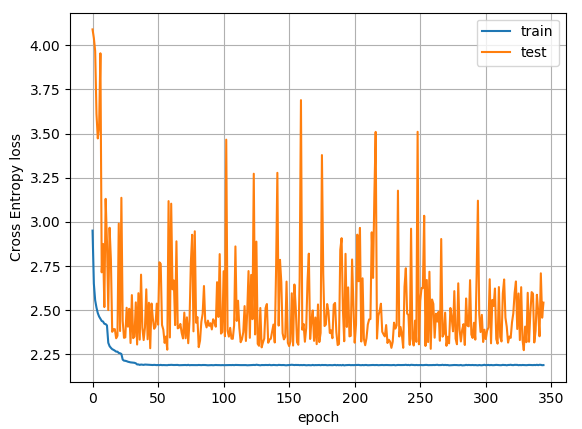
![]() for the testing phase. It is clear that if I do not use model.eval() during the test phase, the test loss is gently decrasing as the traing loss. But, this is not allowed, isn’t it?
for the testing phase. It is clear that if I do not use model.eval() during the test phase, the test loss is gently decrasing as the traing loss. But, this is not allowed, isn’t it?![]()
